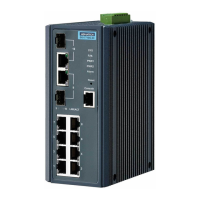EKI-7710 Series User Manual 47
To access this page, click L2 Switching > Link Aggregation > Load Balance.
Figure 4.17 L2 Switching > Link Aggregation > Load Balance
The following table describes the items in the previous figure.
The ensuing table for Load Balance Information settings are informational only:
Load Balance Algorithm.
4.5.3.2 LAG Management
Link aggregation is also known as trunking. It is a feature available on the Ethernet
gateway and is used with Layer 2 Bridging. Link aggregation allows for the logical
merging of multiple ports into a single link.
To access this page, click L2 Switching > Link Aggregation > LAG Management.
Figure 4.18 L2 Switching > Link Aggregation > LAG Management
The following table describes the items in the previous figure.
The ensuing table for LAG Management Information settings are informational
only: LAG, Name, Type, Link State, Active Member, Standby Member, Edit (click to
modify the settings) and Clear (click to load default settings).
4.5.3.3 LAG Port Settings
The LAG Port Settings page allows you to enable or disable, set LAG status, speed
and flow control functions.
In this example we will configure a LAG between the following switches:
Item Description
Load Balance Algo-
rithm
Select the radio button to select the Load Balance Setting: MAC
Address or IP/MAC Address.
Apply Click Apply to save the values and update the screen.
Item Description
LAG Click the drop-down menu to select the designated trunk group:
Trunk 1 ~8.
Name Enter an entry to specify the LAG name.
Type Click the radio button to specify the type mode: Static or LACP.
Ports Click the drop-down menu to select designated ports: Port1-10.
Apply Click Apply to save the values and update the screen.

